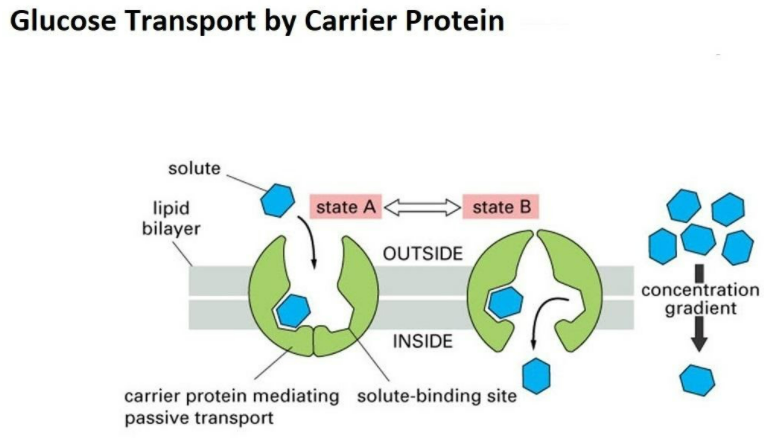
Can Carbohydrates pass through the Cell Membrane?
Answer
393.3k+ views
1 likes
Hint: In the cell membrane, carbohydrates are the major components, placed on the outermost of the cells, bound to lipids or proteins. The membrane carbohydrates are involved in cell-to-cell recognition and cell adhesions, acting as a physical barrier. Large and uncharged molecules like glucose cannot diffuse through membranes. But the selected processes permit the passage of carbohydrates via the cell membrane because it is selectively permeable.
Complete answer:

Fig: Transport of Glucose by Carrier Protein GLUT
Glucose is a larger molecule, which makes it hard to pass through the cell membrane via simple diffusion. In this case, lipids aid glucose to pass through the cell membrane. They carry glucose via active transport and are diffused towards the membranes of the red blood cells.
Facilitated diffusion allows charged and polar molecules to pass through the cell membrane. Facilitated diffusion is mediated by two classes of proteins, namely carrier proteins and channel proteins. Carrier proteins bind to particular molecules to be transported on one side of the molecule and then undergo conformational changes which allow the molecule to pass through the membrane and be released on another side.
Channel proteins form open pores via the cell membrane, allowing free diffusion of any molecule of appropriate charge and size.
Carrier proteins are liable for the facilitated diffusion of amino acids, sugars, and nucleosides across the cell membrane of several cells. The uptake of glucose could be a predominant source of metabolic energy and is one of the foremost functions of the plasma membrane. The glucose transporter is a good model of carrier protein.
The glucose transporter is initially identified as a
Note:
The glucose transporter functions by alternating between two states. Initially, a glucose-binding site faces the outward side of the cell. But, the site faces inside of the cell when the binding of the glucose molecule induces a conformational change within the transporter. Then, the glucose can be released into the cytosol, following which, the initial conformation returns. This mechanism happens in the plasma membrane of red blood cells.
Complete answer:

Fig: Transport of Glucose by Carrier Protein GLUT
Glucose is a larger molecule, which makes it hard to pass through the cell membrane via simple diffusion. In this case, lipids aid glucose to pass through the cell membrane. They carry glucose via active transport and are diffused towards the membranes of the red blood cells.
Facilitated diffusion allows charged and polar molecules to pass through the cell membrane. Facilitated diffusion is mediated by two classes of proteins, namely carrier proteins and channel proteins. Carrier proteins bind to particular molecules to be transported on one side of the molecule and then undergo conformational changes which allow the molecule to pass through the membrane and be released on another side.
Channel proteins form open pores via the cell membrane, allowing free diffusion of any molecule of appropriate charge and size.
Carrier proteins are liable for the facilitated diffusion of amino acids, sugars, and nucleosides across the cell membrane of several cells. The uptake of glucose could be a predominant source of metabolic energy and is one of the foremost functions of the plasma membrane. The glucose transporter is a good model of carrier protein.
The glucose transporter is initially identified as a
Note:
The glucose transporter functions by alternating between two states. Initially, a glucose-binding site faces the outward side of the cell. But, the site faces inside of the cell when the binding of the glucose molecule induces a conformational change within the transporter. Then, the glucose can be released into the cytosol, following which, the initial conformation returns. This mechanism happens in the plasma membrane of red blood cells.
Recently Updated Pages
Master Class 11 Business Studies: Engaging Questions & Answers for Success

Master Class 11 Accountancy: Engaging Questions & Answers for Success

Master Class 11 Computer Science: Engaging Questions & Answers for Success

Master Class 11 English: Engaging Questions & Answers for Success

Master Class 11 Social Science: Engaging Questions & Answers for Success

Master Class 11 Economics: Engaging Questions & Answers for Success

Trending doubts
Which one is a true fish A Jellyfish B Starfish C Dogfish class 11 biology CBSE

State and prove Bernoullis theorem class 11 physics CBSE

1 ton equals to A 100 kg B 1000 kg C 10 kg D 10000 class 11 physics CBSE

In which part of the body the blood is purified oxygenation class 11 biology CBSE

One Metric ton is equal to kg A 10000 B 1000 C 100 class 11 physics CBSE

Difference Between Prokaryotic Cells and Eukaryotic Cells




